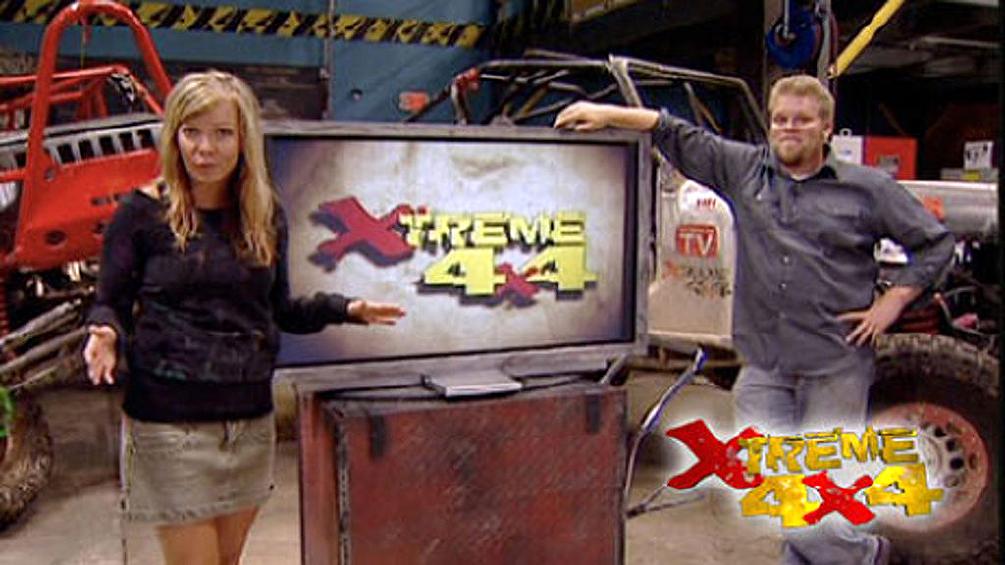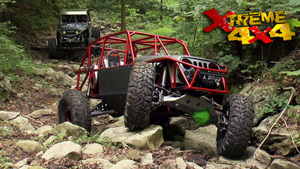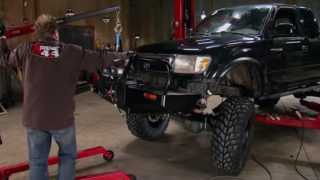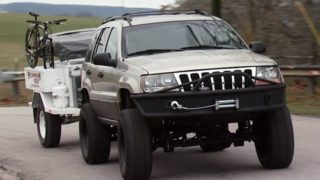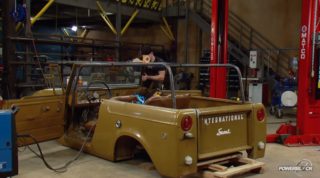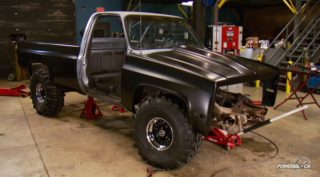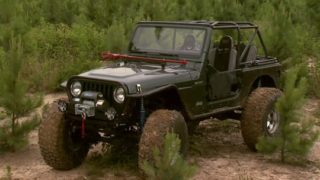More Ranger Resurection Episodes
Xtreme 4x4 Builds
Want more content like this?
Join the PowerNation Email NewsletterParts Used In This Episode
Rhino Brands
Rhino Off Road Industries
Tellico 4X4
Upper Tellico OHV
WyoTech
WyoTech
Episode Transcript
Build them, break them and build them back up again. Today on Xtreme 4x4, the ranger is resurrected for good. Plus another Christening of Ian and Jesse's creations when the poison spider hits the trail hard.
Hey, everybody. Welcome to Xtreme 4x4 where today we're tearing back into our poisonous spider bruiser eight Rock rock, basically finishing up all the odds and ends on that truck like the axle shafts, drive shafts, brake pedals and brake lines, everything we need to get this truck on the trail by the end of the day, it will be on the trail.
And I know you guys are probably thinking, man, I hope this payoff is going to be better than their last payoff they did on the ranger,
but you guys waited for that truck to get done forever. So today we're going to fix it and take it out as well.
Our
bruiser a chassis was delivered to us by the guys that poison Spider customs located in Denver, Colorado
and it took us no time at all to stuff. An all aluminum LS 14 L 65 E trans and Atlas two transfer case. Let me pull that safety.
Yep into our new tube chassis,
then it was time to sling some gifts under our new beast.
And since you guys asked for more junkyard rebuilds, we started with two data sixties and built them from scratch with new superior gears
and Detroit lockers, front and rear.
Then we had a rolling chassis that we filled with mastercraft seats,
auto meter gauges
and of course, painless performance wiring
and with our axles fully assembled, we could go ahead and measure for and order our custom axle shaft from superior axle and gear. Now, the rear, all we had to do was send the old shafts out and have these new ones match to them. But the front since all we started with was the center section are 100% custom,
ours are from superior as well and the in and out of shafts will be connected with rebuildable CTMU joints.
And at the wheel, we will use poly performance drive blanches
with axle shafts in our differentials. We can go ahead and install our drive shafts. Now, ours came from Denny's drive shaft.
They're heavy duty steel units with super strong 1350 U joints at the axle.
And
the way you can make sure you have enough slip travel in your drive shaft is pretty simple. You just have to take three
measurements.
The first one you extend your suspension all the way out to its limits and measure from the transfer case to the axle and pull the springs out and let it compress all the way, same measurement
and then the same measurement again with it sitting on its springs at rin height, those three measurements to your drive shaft guy, you get a shaft that fits every time
when it comes to the breaks on our bruiser, a chassis. There's a lot of scenarios that we discussed and the most obvious would be to run ad
master cylinder. But the advantage of having an at least to transfer case is that you can run each axle independently and do front or digs,
which means you can hit the brake on one axle and the other axle digs in allowing the buggy to do really tight turns.
But then it came to us why run one
pal when we can run two pedals. So we called up, we would and they sent us to pedal assemblies and 278 rebuildable master cylinders,
we built a custom mountain bracket so we can put the pedal side by side and close together.
We're using crown performance graded lines for all of our brake lines, using flex lines will make the install very easy and quick.
The LS series of engines is a little more complicated than G M's other crate engines. First of all, it does not ship with any accessory drives. So we went ahead and installed the March performance full Polish drive on the front of this engine. But the big difference is in the fuel delivery,
the L
fuel pump in the tank has an internal return bypass. There's only one fuel line running up to the engine.
But on any aftermarket fuel cell like our tank from Rock Valley, it's going to have two lines of feed and a return. So to run that type of system, you got to swap out the fuel rail.
The fuel rail is simply removed from the top of the engine.
Then the fuel injectors are swapped from one rail to another along with the fuel pressure regulator,
the new rail can be bolted to the mo
we're going to be using Russells dash
six still break
line with an in line fuel filter. Now, inside this fuel cell, there's a so
filter that will keep the dirt from damaging the fuel pump. But this finer screen unit will help keep di from damaging our injectors.
All right. Now, when you're running your fuel lines through the chassis, you want to make sure that you're keeping clear of any heat source. In our case, we have exhaust on both sides and even if we run it down the middle, we still have a chance of getting heat from the transmission.
So we're going to be wrapping it in this heat protective shield just to be safe.
Now, all we have to do is check the computer for codes and all our electrical connections.
Top up the fluids, it's fall,
flip the switches and hit the key to hear it all fire up.
It's an LS one baby
later on a broken bolt. Did this to the ranger. Ian and Jessi make prepares and put both on the trail. But up next, the best in the desert proves to be one wild ride. Stay tuned.
Welcome back to Xtreme 4x4. This week in our window to the off road world, we're going desert racing and if you don't have a desert truck, no worries because riding shotgun as a Navigator is just as much fun.
It doesn't matter if it's a buggy or a trophy truck. A best in the desert race is all about surviving. The Nevada moons game
roll.
The desert is tough.
The desert is surprising.
The desert is unforgiven
over 400 miles missing body parts and broken trucks are par for this course.
That's what racing off road is all about. It's view the machine in a desert, you're right on the edge and that's kind of where you want to stay just slightly off total maniac to endure out here takes more than a great driver and a bulletproof rig.
The Navigators have become a very, very important part of our racing.
These men riding shotgun do more than hold them back. The function is just to help the driver out with anything he needs. One of the most important things that the co driver does is keeps track of all of the critical systems on the car that allows the driver to concentrate 100% on driving. Also, I keep track of dangers ahead
right there. Right there.
They even handle more intimate chores. I'll keep food on my side of the vehicle and whenever the driver needs some food,
I open it up, I break it into bite size pieces, hand it over that type of thing.
So it's just, it's kind of like being a wife or a girlfriend riding along. That's what wins races. You've got to help each other out. It's a team effort from that. Intimacy comes a connection with their driver.
The more time you spend with this same person,
the better team you become, you're trying to focus when you race and the more you, you race with that person,
the better off
you are, they know what you want. It takes a special person to be a right hand man.
Everything, everything looks good.
Most good navigators are probably
intellects
because they like to think they like to analyze. They like to read the charts.
They like to, you know, keep on top of the GPS, see what's coming up
and, and be a part of, of that action of it.
That's the danger up there. It's mark too. It can be a little scary over there. Personally, I can't sit over there, I can't sit over there with anybody. It, it just, I, I can't,
I'm just not sure what they're going to do and I'm just not a good rider. They have to really trust the driver and they need to be trusting and think that everything's going to work out. It always doesn't. But they need to think that way,
you know, I'll drive vehicles in pre runs and stuff like that.
And yes, it is much easier to drive, I think, than to ride.
You don't have control. You're just sitting here pretty much, you know,
it's exciting. You're at, you're at the edge of your seat pretty much at all times.
Ever been a time through some section
where I'm sitting there going. I can't believe I'm here. I sure wish I was sitting in a lawn chair somewhere. Those times have happened
when you get on something a little smoother. Your speed picks up past somebody
and
all of the
that's all forgotten and, and it's just a great, it's a great time again.
I just love it because not too many people get to do it and you're just out there in the middle of nowhere
going as fast as you can just pushing the limits and everything. And it's, uh, it's
just an awesome feeling
as much fun as it was riding shotgun in the first two attempts in the ranger. I think this time you're gonna navigate
no sweat. Jessi.
Hey guys, welcome back to Xtreme 4x4. We just finished the poison spider and while we go over everything so we can get out, we want to go ahead and fix the ranger so we can get back on the trailer it belongs.
Now, building this ranger was no simple task considering all that's left of the donor vehicle we dragged to the junkyard is just a cab and about 3 ft of frame rail. But unfortunately for us, our ranger resurrection was rather short lived.
As a matter of fact, this is how we had to get the truck back on our trailer. Not a pretty sight for sure. Good to have a friend named Darren with a front end loader nearby.
But 10 minutes before this, the ranger was running great scaring trees
and our cameraman
and now that we have the truck back here at extreme, we've been able to take a good look at it and we've tracked down the start of the whole problem.
Originally, we had thought that it was this time joint on the front of the upper link. But when we took a closer look, this is what we found
on the rear lower link. A grade five bolt was inadvertently installed, sheared right off and created the whole chain reaction.
And I know you guys are probably thinking, didn't I and Jesse's to
use nothing other than a grade eight bolt for all your off road suspension. Well, unfortunately, in the rush of getting everything done, this little sucker slipped right through the cracks
and that just goes to show you that you really got to watch every single thing go over everything before you hit the trail because one small oversight can cause a lot of damage.
We're going to upgrade to a larger three quarter inch bolt in the front. So we got to redesign the lower amount
all they have to do. We
gusted it right here. Should
be
too
much.
The new upper le mounts will be built using the same bey
through the frame design that we did on the rear. This will ensure that the only way this can break now is if the entire frame rail fails.
Now, when those front link mounts let go. Basically, the only thing holding our front axle underneath our truck were our shock absorbers. Now, there's no way a shock can come out of a wreck like that undamaged and ours are no different. Unfortunately, one of ours is bent and this shaft actually has been sheared right off at the lower he
now it's not that big of a deal because when you're using rebuildable shocks, like our Bill Steins parts are easy to come by. As a matter of fact, all we had to do was call up Bill Stein's shocks, explain the problem and they sent us two new lower shafts for our shock absorbers and replacing these is actually a lot easier than you think
with the shock body and,
and the nitrogen release,
I will remove the rod guide from the bottom of the tube.
Then the rod can slide out with the valve pack bolted to it.
The valve pack to the new shock rod
and reassemble the shock
and install the springs.
Yeah,
here you go, Jessi one down,
one to go. Perfect timing. Thank you.
All right. Now that I have a fixed shock, I can go ahead and put in some beef or lower mounts because before all we had were these little tabs that sheared right off when everything went kaboom
earlier, I went ahead and built some extra heavy duty mouth
with
Gus
and take welding for super duper strength.
Once I get the shock position, I can finish welding in the lower mounts.
Then gus it the rest for strength.
And the last item to repair on this ranger is the drive shaft.
One call to Tom Woods explaining what had happened
and he sent us a new front slip yoke.
Don't go anywhere. Ranger and Spider take on the rocks when Xtreme 4x4 continues.
Welcome back to Xtreme 4x4 with both trucks trailer up.
We headed to a nearby off road park to give them a go.
The inaugural run for the Spider.
You wanna come for a ride
don
in man.
And hopefully third time's a charm for our rangers.
The hardest job when building our poison spider rock rod was creating an entire front axle from scratch, starting with only a center section.
But once on the trail, it was obviously the right decision
from the custom wid to the beefy superior shafts and ctmu joints
we knew it could handle anything we threw at it
with
ginormous flex.
And
thanks to our double triangulated for
and Bill
Rock Hall coil overs. The spider tackled with these obstacles that required a lot of articulation
gearing is the Spider's secret weapon with 529 s in the axles, ultimate low Atlas two with a 5 to 1 and our deep first gear ratio in the four L 65 E transmission.
The spider crawled up most trails just off
idle,
but that doesn't mean it's only built for so cruising
a
pal
stop.
It's that hydraulic steering because you don't have full hydraulic steering. When you're on your side like that, you can't get the tire to turn back underneath you. But full hydraulic, you're basically lifting the whole way to the of the truck up and then you just put a reversal on just back right out.
The ranger finally performed like a champ
agile on the rocks
and a beast out in the open
together. A great juxtaposition
one, a tube chassis purposely built
the other, a pickup that was cut up and rebuilt
all
of them. Totally wicked.
I
just need one dry spot
that,
all right. There you go, guys, two trucks, one back on the trail and one on the trail for the first time. I think all in, all pretty good day. What do you think? I think they both kicked some hardcore
because they did very well. They handled awesome.
I think we did a really good job.
It was a good day.
You should be proud of us
as much as we're proud of us.
Show Full Transcript
Hey, everybody. Welcome to Xtreme 4x4 where today we're tearing back into our poisonous spider bruiser eight Rock rock, basically finishing up all the odds and ends on that truck like the axle shafts, drive shafts, brake pedals and brake lines, everything we need to get this truck on the trail by the end of the day, it will be on the trail.
And I know you guys are probably thinking, man, I hope this payoff is going to be better than their last payoff they did on the ranger,
but you guys waited for that truck to get done forever. So today we're going to fix it and take it out as well.
Our
bruiser a chassis was delivered to us by the guys that poison Spider customs located in Denver, Colorado
and it took us no time at all to stuff. An all aluminum LS 14 L 65 E trans and Atlas two transfer case. Let me pull that safety.
Yep into our new tube chassis,
then it was time to sling some gifts under our new beast.
And since you guys asked for more junkyard rebuilds, we started with two data sixties and built them from scratch with new superior gears
and Detroit lockers, front and rear.
Then we had a rolling chassis that we filled with mastercraft seats,
auto meter gauges
and of course, painless performance wiring
and with our axles fully assembled, we could go ahead and measure for and order our custom axle shaft from superior axle and gear. Now, the rear, all we had to do was send the old shafts out and have these new ones match to them. But the front since all we started with was the center section are 100% custom,
ours are from superior as well and the in and out of shafts will be connected with rebuildable CTMU joints.
And at the wheel, we will use poly performance drive blanches
with axle shafts in our differentials. We can go ahead and install our drive shafts. Now, ours came from Denny's drive shaft.
They're heavy duty steel units with super strong 1350 U joints at the axle.
And
the way you can make sure you have enough slip travel in your drive shaft is pretty simple. You just have to take three
measurements.
The first one you extend your suspension all the way out to its limits and measure from the transfer case to the axle and pull the springs out and let it compress all the way, same measurement
and then the same measurement again with it sitting on its springs at rin height, those three measurements to your drive shaft guy, you get a shaft that fits every time
when it comes to the breaks on our bruiser, a chassis. There's a lot of scenarios that we discussed and the most obvious would be to run ad
master cylinder. But the advantage of having an at least to transfer case is that you can run each axle independently and do front or digs,
which means you can hit the brake on one axle and the other axle digs in allowing the buggy to do really tight turns.
But then it came to us why run one
pal when we can run two pedals. So we called up, we would and they sent us to pedal assemblies and 278 rebuildable master cylinders,
we built a custom mountain bracket so we can put the pedal side by side and close together.
We're using crown performance graded lines for all of our brake lines, using flex lines will make the install very easy and quick.
The LS series of engines is a little more complicated than G M's other crate engines. First of all, it does not ship with any accessory drives. So we went ahead and installed the March performance full Polish drive on the front of this engine. But the big difference is in the fuel delivery,
the L
fuel pump in the tank has an internal return bypass. There's only one fuel line running up to the engine.
But on any aftermarket fuel cell like our tank from Rock Valley, it's going to have two lines of feed and a return. So to run that type of system, you got to swap out the fuel rail.
The fuel rail is simply removed from the top of the engine.
Then the fuel injectors are swapped from one rail to another along with the fuel pressure regulator,
the new rail can be bolted to the mo
we're going to be using Russells dash
six still break
line with an in line fuel filter. Now, inside this fuel cell, there's a so
filter that will keep the dirt from damaging the fuel pump. But this finer screen unit will help keep di from damaging our injectors.
All right. Now, when you're running your fuel lines through the chassis, you want to make sure that you're keeping clear of any heat source. In our case, we have exhaust on both sides and even if we run it down the middle, we still have a chance of getting heat from the transmission.
So we're going to be wrapping it in this heat protective shield just to be safe.
Now, all we have to do is check the computer for codes and all our electrical connections.
Top up the fluids, it's fall,
flip the switches and hit the key to hear it all fire up.
It's an LS one baby
later on a broken bolt. Did this to the ranger. Ian and Jessi make prepares and put both on the trail. But up next, the best in the desert proves to be one wild ride. Stay tuned.
Welcome back to Xtreme 4x4. This week in our window to the off road world, we're going desert racing and if you don't have a desert truck, no worries because riding shotgun as a Navigator is just as much fun.
It doesn't matter if it's a buggy or a trophy truck. A best in the desert race is all about surviving. The Nevada moons game
roll.
The desert is tough.
The desert is surprising.
The desert is unforgiven
over 400 miles missing body parts and broken trucks are par for this course.
That's what racing off road is all about. It's view the machine in a desert, you're right on the edge and that's kind of where you want to stay just slightly off total maniac to endure out here takes more than a great driver and a bulletproof rig.
The Navigators have become a very, very important part of our racing.
These men riding shotgun do more than hold them back. The function is just to help the driver out with anything he needs. One of the most important things that the co driver does is keeps track of all of the critical systems on the car that allows the driver to concentrate 100% on driving. Also, I keep track of dangers ahead
right there. Right there.
They even handle more intimate chores. I'll keep food on my side of the vehicle and whenever the driver needs some food,
I open it up, I break it into bite size pieces, hand it over that type of thing.
So it's just, it's kind of like being a wife or a girlfriend riding along. That's what wins races. You've got to help each other out. It's a team effort from that. Intimacy comes a connection with their driver.
The more time you spend with this same person,
the better team you become, you're trying to focus when you race and the more you, you race with that person,
the better off
you are, they know what you want. It takes a special person to be a right hand man.
Everything, everything looks good.
Most good navigators are probably
intellects
because they like to think they like to analyze. They like to read the charts.
They like to, you know, keep on top of the GPS, see what's coming up
and, and be a part of, of that action of it.
That's the danger up there. It's mark too. It can be a little scary over there. Personally, I can't sit over there, I can't sit over there with anybody. It, it just, I, I can't,
I'm just not sure what they're going to do and I'm just not a good rider. They have to really trust the driver and they need to be trusting and think that everything's going to work out. It always doesn't. But they need to think that way,
you know, I'll drive vehicles in pre runs and stuff like that.
And yes, it is much easier to drive, I think, than to ride.
You don't have control. You're just sitting here pretty much, you know,
it's exciting. You're at, you're at the edge of your seat pretty much at all times.
Ever been a time through some section
where I'm sitting there going. I can't believe I'm here. I sure wish I was sitting in a lawn chair somewhere. Those times have happened
when you get on something a little smoother. Your speed picks up past somebody
and
all of the
that's all forgotten and, and it's just a great, it's a great time again.
I just love it because not too many people get to do it and you're just out there in the middle of nowhere
going as fast as you can just pushing the limits and everything. And it's, uh, it's
just an awesome feeling
as much fun as it was riding shotgun in the first two attempts in the ranger. I think this time you're gonna navigate
no sweat. Jessi.
Hey guys, welcome back to Xtreme 4x4. We just finished the poison spider and while we go over everything so we can get out, we want to go ahead and fix the ranger so we can get back on the trailer it belongs.
Now, building this ranger was no simple task considering all that's left of the donor vehicle we dragged to the junkyard is just a cab and about 3 ft of frame rail. But unfortunately for us, our ranger resurrection was rather short lived.
As a matter of fact, this is how we had to get the truck back on our trailer. Not a pretty sight for sure. Good to have a friend named Darren with a front end loader nearby.
But 10 minutes before this, the ranger was running great scaring trees
and our cameraman
and now that we have the truck back here at extreme, we've been able to take a good look at it and we've tracked down the start of the whole problem.
Originally, we had thought that it was this time joint on the front of the upper link. But when we took a closer look, this is what we found
on the rear lower link. A grade five bolt was inadvertently installed, sheared right off and created the whole chain reaction.
And I know you guys are probably thinking, didn't I and Jesse's to
use nothing other than a grade eight bolt for all your off road suspension. Well, unfortunately, in the rush of getting everything done, this little sucker slipped right through the cracks
and that just goes to show you that you really got to watch every single thing go over everything before you hit the trail because one small oversight can cause a lot of damage.
We're going to upgrade to a larger three quarter inch bolt in the front. So we got to redesign the lower amount
all they have to do. We
gusted it right here. Should
be
too
much.
The new upper le mounts will be built using the same bey
through the frame design that we did on the rear. This will ensure that the only way this can break now is if the entire frame rail fails.
Now, when those front link mounts let go. Basically, the only thing holding our front axle underneath our truck were our shock absorbers. Now, there's no way a shock can come out of a wreck like that undamaged and ours are no different. Unfortunately, one of ours is bent and this shaft actually has been sheared right off at the lower he
now it's not that big of a deal because when you're using rebuildable shocks, like our Bill Steins parts are easy to come by. As a matter of fact, all we had to do was call up Bill Stein's shocks, explain the problem and they sent us two new lower shafts for our shock absorbers and replacing these is actually a lot easier than you think
with the shock body and,
and the nitrogen release,
I will remove the rod guide from the bottom of the tube.
Then the rod can slide out with the valve pack bolted to it.
The valve pack to the new shock rod
and reassemble the shock
and install the springs.
Yeah,
here you go, Jessi one down,
one to go. Perfect timing. Thank you.
All right. Now that I have a fixed shock, I can go ahead and put in some beef or lower mounts because before all we had were these little tabs that sheared right off when everything went kaboom
earlier, I went ahead and built some extra heavy duty mouth
with
Gus
and take welding for super duper strength.
Once I get the shock position, I can finish welding in the lower mounts.
Then gus it the rest for strength.
And the last item to repair on this ranger is the drive shaft.
One call to Tom Woods explaining what had happened
and he sent us a new front slip yoke.
Don't go anywhere. Ranger and Spider take on the rocks when Xtreme 4x4 continues.
Welcome back to Xtreme 4x4 with both trucks trailer up.
We headed to a nearby off road park to give them a go.
The inaugural run for the Spider.
You wanna come for a ride
don
in man.
And hopefully third time's a charm for our rangers.
The hardest job when building our poison spider rock rod was creating an entire front axle from scratch, starting with only a center section.
But once on the trail, it was obviously the right decision
from the custom wid to the beefy superior shafts and ctmu joints
we knew it could handle anything we threw at it
with
ginormous flex.
And
thanks to our double triangulated for
and Bill
Rock Hall coil overs. The spider tackled with these obstacles that required a lot of articulation
gearing is the Spider's secret weapon with 529 s in the axles, ultimate low Atlas two with a 5 to 1 and our deep first gear ratio in the four L 65 E transmission.
The spider crawled up most trails just off
idle,
but that doesn't mean it's only built for so cruising
a
pal
stop.
It's that hydraulic steering because you don't have full hydraulic steering. When you're on your side like that, you can't get the tire to turn back underneath you. But full hydraulic, you're basically lifting the whole way to the of the truck up and then you just put a reversal on just back right out.
The ranger finally performed like a champ
agile on the rocks
and a beast out in the open
together. A great juxtaposition
one, a tube chassis purposely built
the other, a pickup that was cut up and rebuilt
all
of them. Totally wicked.
I
just need one dry spot
that,
all right. There you go, guys, two trucks, one back on the trail and one on the trail for the first time. I think all in, all pretty good day. What do you think? I think they both kicked some hardcore
because they did very well. They handled awesome.
I think we did a really good job.
It was a good day.
You should be proud of us
as much as we're proud of us.
